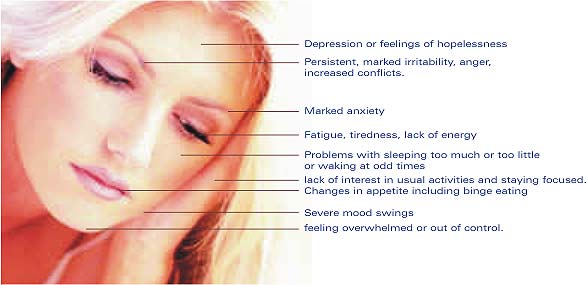|
|
Premenstrual Dysphoric Disorder (PMDD)
Premenstrual
Dysphoric Disorder(PMDD)
|
|
|
|
|
|
|
|
|
 Premenstrual dysphoric disorder or PMDD is a condition associated with severe
emotional and physical problems that are linked closely to the menstrual cycle.
Symptoms occur regularly in the second half of the cycle and end when
menstruation begins or shortly thereafter. PMDD is not just a new name for
premenstrual syndrome (PMS), a condition that affects as many as 75% of
menstruating women. It is, however, considered to be a very severe form of PMS
that affects about 5% of menstruating women. PMDD is also a psychiatric term for
a major mood disturbance. "Dysphoria" derives from a Greek word
meaning "distress" or "hard to bear". It generally refers to
a type of depression. Premenstrual dysphoric disorder or PMDD is a condition associated with severe
emotional and physical problems that are linked closely to the menstrual cycle.
Symptoms occur regularly in the second half of the cycle and end when
menstruation begins or shortly thereafter. PMDD is not just a new name for
premenstrual syndrome (PMS), a condition that affects as many as 75% of
menstruating women. It is, however, considered to be a very severe form of PMS
that affects about 5% of menstruating women. PMDD is also a psychiatric term for
a major mood disturbance. "Dysphoria" derives from a Greek word
meaning "distress" or "hard to bear". It generally refers to
a type of depression.
PMDD usually begins when a woman is in her teens to late 20s, although women
who seek treatment are usually in their 30s.
PMS vs. PMDD
Premenstrual syndrome (PMS) refers to the variation of physical and
mood symptoms that appear during the last one or two weeks of the menstrual
cycle and disappear by the end of a full flow of menses. This is a diagnosis
used by Ob-Gyns and primary care physicians. Psychiatrists and other mental
health workers tend to use the diagnosis term of premenstrual dysphoric
disorder (PMDD) to describe a specific set of mood symptoms that are also
present the week before menses and remit a few days after the start of menses
and also interfere with social or role functioning.
PMS looks more at physical symptoms such as bloating, weight gain, breast
tenderness, swelling of hands and feet, aches and pains, poor concentration,
sleep disturbance, appetite change, and psychologic discomfort.
Premenstrual dysphoric disorder has as part of its definition, symptoms such
as depressed mood or dysphoria, anxiety or tension, emotional lability,
irritability, decreased interest in usual activities, concentration
difficulties, marked lack of energy, marked change in appetite, overeating or
food cravings, sleepiness or insomnia, and feeling overwhelmed.
Symptoms of
Premenstrual Dysphoric Disorder
PMDD symptoms begin sometime after the middle of a monthly cycle (after
ovulation), usually get worse during the week before menses, and then usually
disappear within a few days of the start of menses.
For a PMDD diagnosis a woman must regularly experience five or more
of the symptoms listed in the DSM-IV (Diagnostic and Statistical Manual of
Mental Disorders) during the premenstrual period, and the symptoms must
seriously impair her ability to function on a day-to-day basis.
Physical Symptoms
Some physical discomfort or pain accompany PMDD , including weight
gain, bloating and tenderness in the breast, abdomen or groin area, headache,
and muscle or joint aches.
Emotional and Psychological Symptoms

Causes of PMDD:
Current theories suggest that normal ovarian function may trigger changes in
brain chemistry in women predisposed to PMDD. One brain chemical that may be
especially important is serotonin, a neurotransmitter. The serotonin system
has a close relationship to the female hormones, and imbalances of the serotonin
system may play an important role in causing PMDD.
Genetics may play a role. Studies have shown that identical twins are
more likely to share the disorder (93%) than non-identical twins (fraternal)
(44%), and daughters of mothers with PMDD are more likely to have it themselves.
However, no specific genes have been identified to account for PMDD.
A woman may be more likely to suffer from PMDD if she has had a major depressive
disorder or has bipolar disorder, or if someone in her family has suffered
from one of these conditions.

The experts recommend that women with severe symptoms use
all the above approaches.
But, for women with less severe symptoms, it may not be necessary to use all 3
approaches at once.
Medications for PMDDT o treat the emotional symptoms of PMDD (e.g., depression, tearfulness, mood
swings, anxiety, anger, irritability, fatigue, difficulty concentrating), the
majority of experts recommend antidepressant medications. One of the most
important treatments for PMDD, then, has been to prescribe selective
serotonin reuptake inhibitors, commonly known as SSRIs. The better-known
SSRIs include such popular brand names as Prozac�, Zoloft�,
Paxil�, Celexa�, and Luvox�. SSRIs have been
successful in treating the depression of many sufferers and have relatively few
side effects. o treat the emotional symptoms of PMDD (e.g., depression, tearfulness, mood
swings, anxiety, anger, irritability, fatigue, difficulty concentrating), the
majority of experts recommend antidepressant medications. One of the most
important treatments for PMDD, then, has been to prescribe selective
serotonin reuptake inhibitors, commonly known as SSRIs. The better-known
SSRIs include such popular brand names as Prozac�, Zoloft�,
Paxil�, Celexa�, and Luvox�. SSRIs have been
successful in treating the depression of many sufferers and have relatively few
side effects.
In case of severe physical symptoms (headache, cramps, bloating, or water
retention), the doctor would combine the antidepressant with a medication for
these physical symptoms, such as a diuretic, an over-the-counter pain medicine
such as ibuprofen (Motrin), or a prescription pain medicine, depending on the
particular problems.
Note: Don�t stop or change the dose of your medication without first
consulting your doctor.
Nutritional Strategies
-
Limiting consumption of alcohol, caffeine, and salt to minimize their
potential adverse effects (eg, nervousness, jitteriness, bloating).
-
Avoiding sugar and eating more complex
carbohydrates
to avoid symptoms resembling
hypoglycemia.
One study reported that a commercially available carbohydrate-rich beverage
improves mood, appetite, and cognitive function when taken in the late
luteal phase.
-
Calcium supplementation during the
luteal phase has proven beneficial wit h
regard to bloating, pain, mood, and food cravings. h
regard to bloating, pain, mood, and food cravings.
-
One recent nonrandomized trial found that a low-fat vegetarian diet
reduced premenstrual symptoms.
Behavioral Approaches
-
 Regular exercise is strongly recommended. Although exercise has not
been studied specifically in PMDD, it has shown benefit in PMS-
aerobic
exercise traditionally is recommended, particularly if depressive or
fluid retention symptoms predominate. The efficacy of exercise could be
because of raised endorphin levels, physiologic changes, and psychological
changes. Regular exercise is strongly recommended. Although exercise has not
been studied specifically in PMDD, it has shown benefit in PMS-
aerobic
exercise traditionally is recommended, particularly if depressive or
fluid retention symptoms predominate. The efficacy of exercise could be
because of raised endorphin levels, physiologic changes, and psychological
changes.
-
 Relaxation techniques, meditation, and
yoga are
recommended-Relaxation response is a physiological response that results in
decreased metabolism, decreased heart rate, decreased blood pressure,
decreased rate of breathing, and slower brain waves. The repetition of a
word, a sound, a prayer, a phrase, or a muscular activity is required to
elicit the relaxation response. Most studies of relaxation techniques have
used them as an adjunct to other modalities of therapy. Relaxation techniques, meditation, and
yoga are
recommended-Relaxation response is a physiological response that results in
decreased metabolism, decreased heart rate, decreased blood pressure,
decreased rate of breathing, and slower brain waves. The repetition of a
word, a sound, a prayer, a phrase, or a muscular activity is required to
elicit the relaxation response. Most studies of relaxation techniques have
used them as an adjunct to other modalities of therapy.
-
Psychotherapies may prove helpful like, cognitive-behavioral and
interpersonal therapies, supportive counseling-Cognitive treatment teaches
the patients about ways to examine these negative patterns and replace them
with more adaptive ways of viewing life events. Cognitive-behavioral therapy
for PMDD includes anger control, thought stopping, and reduction of negative
emotions through cognitive restructuring.
For severe symptoms that have not responded to any other strategies, the
doctor may also discuss using medication to block ovulation (creating a
�chemical menopause�).Since ovulation appears to be the trigger for PMDD,
the cessation of ovulation is clearly warranted for extreme cases. A medical
method for causing the cessation of ovulation is the use of gonadotropin-releasing
hormone agonists (GnRH agonists). The problem with GnRH agonists, however, is
that many women find the side effects unacceptable. They include weight gain,
increased facial hair, and acne, among others. Worse yet, the cost of this
medication is very high�almost $500 a month.
A second method for stopping ovulation is with hormonal treatments. For example,
scientists are studying the use of progestin and estradiol. Results are not
available, though, and these approaches have not yet been deemed safe and
effective for PMDD.A third strategy for ending ovulation prior to menopause is
the surgical removal of the ovaries. Needless to say, this is a drastic and
invasive approach that is reserved for extreme cases. The effects of such
surgery are similar to the onset of menopause: increased risk of osteoporosis
and loss of libido are
|
|
|
|
|

 o treat the emotional symptoms of PMDD (e.g., depression, tearfulness, mood
swings, anxiety, anger, irritability, fatigue, difficulty concentrating), the
majority of experts recommend antidepressant medications. One of the most
important treatments for PMDD, then, has been to prescribe selective
serotonin reuptake inhibitors, commonly known as SSRIs. The better-known
SSRIs include such popular brand names as Prozac�, Zoloft�,
Paxil�, Celexa�, and Luvox�. SSRIs have been
successful in treating the depression of many sufferers and have relatively few
side effects.
o treat the emotional symptoms of PMDD (e.g., depression, tearfulness, mood
swings, anxiety, anger, irritability, fatigue, difficulty concentrating), the
majority of experts recommend antidepressant medications. One of the most
important treatments for PMDD, then, has been to prescribe selective
serotonin reuptake inhibitors, commonly known as SSRIs. The better-known
SSRIs include such popular brand names as Prozac�, Zoloft�,
Paxil�, Celexa�, and Luvox�. SSRIs have been
successful in treating the depression of many sufferers and have relatively few
side effects.
 h
regard to bloating, pain, mood, and food cravings.
h
regard to bloating, pain, mood, and food cravings. Regular exercise is strongly recommended. Although exercise has not
been studied specifically in PMDD, it has shown benefit in PMS-
aerobic
exercise traditionally is recommended, particularly if depressive or
fluid retention symptoms predominate. The efficacy of exercise could be
because of raised endorphin levels, physiologic changes, and psychological
changes.
Regular exercise is strongly recommended. Although exercise has not
been studied specifically in PMDD, it has shown benefit in PMS-
aerobic
exercise traditionally is recommended, particularly if depressive or
fluid retention symptoms predominate. The efficacy of exercise could be
because of raised endorphin levels, physiologic changes, and psychological
changes. Relaxation techniques, meditation, and
yoga are
recommended-Relaxation response is a physiological response that results in
decreased metabolism, decreased heart rate, decreased blood pressure,
decreased rate of breathing, and slower brain waves. The repetition of a
word, a sound, a prayer, a phrase, or a muscular activity is required to
elicit the relaxation response. Most studies of relaxation techniques have
used them as an adjunct to other modalities of therapy.
Relaxation techniques, meditation, and
yoga are
recommended-Relaxation response is a physiological response that results in
decreased metabolism, decreased heart rate, decreased blood pressure,
decreased rate of breathing, and slower brain waves. The repetition of a
word, a sound, a prayer, a phrase, or a muscular activity is required to
elicit the relaxation response. Most studies of relaxation techniques have
used them as an adjunct to other modalities of therapy.



 Premenstrual dysphoric disorder or PMDD is a condition associated with severe
emotional and physical problems that are linked closely to the menstrual cycle.
Symptoms occur regularly in the second half of the cycle and end when
menstruation begins or shortly thereafter. PMDD is not just a new name for
premenstrual syndrome (PMS), a condition that affects as many as 75% of
menstruating women. It is, however, considered to be a very severe form of PMS
that affects about 5% of menstruating women. PMDD is also a psychiatric term for
a major mood disturbance. "Dysphoria" derives from a Greek word
meaning "distress" or "hard to bear". It generally refers to
a type of depression.
Premenstrual dysphoric disorder or PMDD is a condition associated with severe
emotional and physical problems that are linked closely to the menstrual cycle.
Symptoms occur regularly in the second half of the cycle and end when
menstruation begins or shortly thereafter. PMDD is not just a new name for
premenstrual syndrome (PMS), a condition that affects as many as 75% of
menstruating women. It is, however, considered to be a very severe form of PMS
that affects about 5% of menstruating women. PMDD is also a psychiatric term for
a major mood disturbance. "Dysphoria" derives from a Greek word
meaning "distress" or "hard to bear". It generally refers to
a type of depression.
